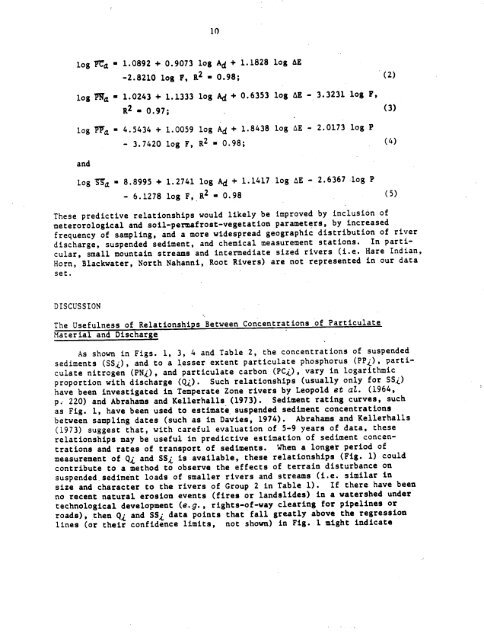The chemistry, mineralogy, and rates of transport of sediments in the ...
The chemistry, mineralogy, and rates of transport of sediments in the ...
The chemistry, mineralogy, and rates of transport of sediments in the ...
Create successful ePaper yourself
Turn your PDF publications into a flip-book with our unique Google optimized e-Paper software.
10<br />
log Pra -<br />
1 .0892 + 0 .9073 log Ad + 1 .1828 log AE<br />
-2 .8210 log F, R2 - 0 .98 ; ( 2 )<br />
log PWg - 1 .0243 + 1 .1333 log Ad + 0 .6353 log AE - 3 .3231 log F,<br />
R2 - 0 .97 ; (3)<br />
log PE - 4 .5434 + 1 .0059 log Ad + 1 .8438 log AE - 2 .0173 log P<br />
<strong>and</strong><br />
- 3 .7420 log F, R 2 - 0 .98 ; ( 4 )<br />
log •STQ - 8 .8995 + 1 .2741 log<br />
Ad + 1 .1417 log AE - 2 .6367-log P<br />
- 6 .1278 log F, R2 - 0 .98 ( 5 )<br />
<strong>The</strong>se predictive relationships would likely be improved by <strong>in</strong>clusion <strong>of</strong><br />
meterorological <strong>and</strong> soil-permafrost-vegetation parameters, by <strong>in</strong>creased<br />
frequency <strong>of</strong> sampl<strong>in</strong>g, <strong>and</strong> a more widespread geographic distribution <strong>of</strong> river<br />
discharge, suspended sediment, <strong>and</strong> chemical measurement stations . In particular,<br />
small mounta<strong>in</strong> streams <strong>and</strong> <strong>in</strong>termediate sized rivers (i .e . Hare Indian,<br />
Horn, Blackwater, North Nahanni, Root Rivers) are not represented <strong>in</strong> our data<br />
set .<br />
DISCUSSION<br />
<strong>The</strong> Usefulness<strong>of</strong>RelationshipsBetweenConcentrations<strong>of</strong>Particulate_<br />
Material <strong>and</strong>Discharge<br />
As shown <strong>in</strong> Figs . 1, 3, 4 <strong>and</strong> Table 2, <strong>the</strong> concentrations <strong>of</strong> suspended<br />
<strong>sediments</strong> (SS4), <strong>and</strong> to a lesser extent particulate phosphorus (PP,), particulate<br />
nitrogen (PNi), <strong>and</strong> particulate carbon (PCB), vary <strong>in</strong> logarithmic<br />
proportion with discharge (Qi) . Such relationships (usually only for SS,)<br />
have been <strong>in</strong>vestigated <strong>in</strong> Temperate Zone rivers by Leopold et al . (1964,<br />
p : 220) <strong>and</strong> Abrahams <strong>and</strong> Kellerhalls (1973) . Sediment rat<strong>in</strong>g curves, such<br />
as Fig . 1, have been used to estimate, suspended sediment concentrations<br />
between sampl<strong>in</strong>g dates (such as <strong>in</strong> Davies, 1974) . Abrahams <strong>and</strong> Kellerhalls<br />
(1973) suggest that, with careful evaluation <strong>of</strong> 5-9 years <strong>of</strong> data, <strong>the</strong>se<br />
relationships may be useful <strong>in</strong> predictive estimation <strong>of</strong> sediment concentrations<br />
<strong>and</strong> <strong>rates</strong> <strong>of</strong> <strong>transport</strong> <strong>of</strong> <strong>sediments</strong> . When a longer period <strong>of</strong><br />
measurement <strong>of</strong> Qi <strong>and</strong> SSi is available,, <strong>the</strong>se relationships (Fig . 1) could<br />
contribute to a method to observe <strong>the</strong> effects <strong>of</strong> terra<strong>in</strong> disturbance on<br />
suspended . sediment loads <strong>of</strong> smaller rivers <strong>and</strong> streams (i .e . similar <strong>in</strong><br />
size <strong>and</strong> character to <strong>the</strong> rivers <strong>of</strong> Group 2 <strong>in</strong> Table 1) . If <strong>the</strong>re have been<br />
no recent natural erosion events (fires or l<strong>and</strong>slides) <strong>in</strong> a watershed under<br />
technological development (e .g ., rights-<strong>of</strong>-way clear<strong>in</strong>g for pipel<strong>in</strong>es or<br />
roads), <strong>the</strong>n Qi <strong>and</strong> SSi data po<strong>in</strong>ts that fall greatly above <strong>the</strong> regression<br />
l<strong>in</strong>es (or <strong>the</strong>ir confidence limits, not shown) <strong>in</strong> Fig . 1 might <strong>in</strong>dicate
















